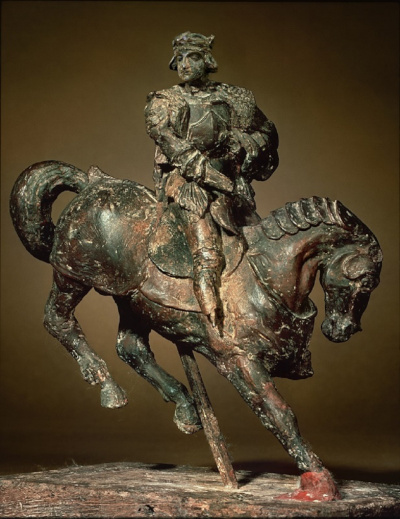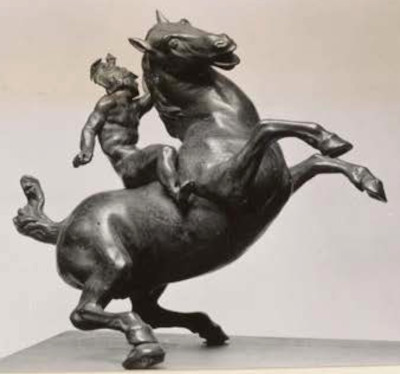Sculptures offered Leonardo da Vinci the opportunity to take his talents into the third dimension. Da Vinci's fame led to several commissions within this artistic discipline, even though he was relatively inexperienced as a sculptor.
Introduction
The Italian Renaissance included many of the finest sculptors ever to have lived and it is worth remembering that Da Vinci served as an apprentice under Verrocchio, an artist who covered many disciplines but was respected most as a sculptor. Indeed, his pupil's qualities as a painter eventually convinced himself to abandon working in that medium and concentrate solely in sculpture.
Da Vinci would have been surrounded by experienced sculptors from whom he could learn, even after he had moved away from his master. His existing donors would often require sculptures to adorn their palaces or religious buildings. The themes and topics would also often be the same as Da Vinci was already covering within his paintings and drawings.
Attribution has proved to be a problem with Leonardo da Vinci sculptures. The two items included without our list are perhaps the most confident of attributions, but there remains a large number of other statues and statuettes which can offer evidence of a connection to the great master. The majority of these capture horses, and this content was regularly requested by donors.
Even in his small oeuvre, the artist would make use of a variety of materials for his work, though the two items included in this page were both cast in bronze. Notes from the artist's career run into the thousands and there are many studies within these of horses. He would learn about their anatomies in great depth, and was therefore able to consider his three dimensional sculptures from every angle.
Statuettes appeared within his work and these would often be used as faster ways of producing sculptures which could then be shown to donors for approval of larger projects. This avoided making large amendments or wasting materials when the donor was not entirely happy with the artistic direction taken. Even masters like Da Vinci would have to work hard to appease those who commissioned their work, many of whom were particularly prominent people, such as Dukes or Cardinals.
Whilst Da Vinci's sculptures will never achieve the same profile as those who specialised in this medium, they still offer an interesting extra avenue of creative output for this talented master. Those more successful and prominent within this discipline would include his master, Verrocchio, as well as Michelangelo and Raphael.
This article presents two sculptures attributed to the artist, and also gives information on Da Vinci's techniques and mediums used within this discipline. We aim to answer the question of why so many of these were related to horses, and also mention other sculptures attributed to his name over the past few centuries. There is also discussion on how his work as a sculptor could impact his contributions to other disciplines such as painting and drawing.
Table of Contents
- Introduction
- List of Leonardo da Vinci Sculptures
- Background
- Completed Sculptures
- Incomplete Sculptures
- Da Vinci's Preference for Painting over Sculpture
- Leonardo within the Milan Court
- References
List of Leonardo da Vinci Sculptures
Find two sculptures attributed to Leonardo da Vinci below. Both carry a relatively strong attribution to the artist, and are accepted by most major experts on the artist. There are a number of other sculptures which continue to be connected to his name, including several further sculptures of horses. Additionally, many drawings exist from his career that could potentially have been study pieces for planned later works in the third dimension, as projects would often be abandoned for a multitude of reasons.
Background
Da Vinci was introduced to a wide variety of artistic disciplines by his master, Verrocchio. He served as an apprentice for a number of years and remained loyal even after leaving the studio in order to go it alone. He would eventually delve into science, mathematics and invention, but the influence of his master encouraged him to work with sculpture later on in his career.
Whilst he was not experienced in this medium, he would have learnt the basics from his time as a young student, and would also be able to consult other sculptors in his circle in later decades. His capabilities were understood by his major donors and they would often ask him to produce commissions rather than choosing others who might have more experience. As a student he worked mainly in plaster and marble.
Completed Sculptures
Horse and Rider (Wax Sculpture) and Rearing Horse and Mounted Warrior are the two completed sculptures confidently attributed to the artist, though a number of others exist that he may also have worked on. The Budapest piece may have required additional help, but the master would have been well involved with the project, such is the style of this item.
Many donors wanted to be portrayed in a strong manner, and riding horseback could provide this symbolism. The same content would appear again within paintings, with many self portraits in this manner continuing into the Baroque era. The debates over attribution which are common throughout the artist's career is reflected in the inconsistent manner in how various publications have addressed Da Vinci's work with sculpture, with some items featured in some books, and not others.
It is likely that further revelations will appear in time, and potentially there may be more sculptures by Da Vinci out there that have yet to be entirely recognised as his own. Existing moulds also offer the opportunity to cast new versions, whilst also giving us an insight into his working techniques.
Incomplete Sculptures
If Da Vinci had completed two planned sculptural projects, his reputation within this discipline would have risen substantially. Sadly, neither would go beyond the planning stage, but in recent years we have seen others produce replicas based on his original designs. These two commissions were for a large equestrian statue as requested by the Duke of Milan, Francesco Sforza, as well as a monument for Marshal Trivulzio that would have come around two decades later.
These major projects excited the artist and convinced him to commit a large amount of time in sketching out how these two sculptures would eventually look. The Duke was a particularly important donor, and so Da Vinci would have placed a particular importance on this commission, which was planned for delivery just before the turn of the century.
Da Vinci's Preference for Painting over Sculpture
Many are unaware that Leonardo actually considered painting to be a more dynamic and rewarding discipline that sculpture. He would often disparage the work of Michelangelo, for example, and believed that his paintings suffered because of his main specialisation. He was quoted specifically as saying:
"...Painting embraces and contains within itself all things perceptible in nature, which the poverty of sculpture cannot do, such as show the colours of all things and their diminution..."
It must be remembered that Da Vinci produced glazes of colour within his portraits that were so lifelike it would amaze the viewer, even within the incredible times of the Renaissance. He therefore understood the beauty of intricate colour, and therefore inevitably found sculpture to be somewhat limited in that regard.
However, perhaps if he had spent more time working as a sculptor, he might have had a better understanding of the alternative opportunities that it offers, such as in its tactile nature, and the balance of light and angle from these three dimensional forms. At times, he may also have been deliberately disparaging Michelangelo as artists sometimes will do, in order to promote their own achievements.
Leonardo within the Milan Court
Despite not considering sculpture to be as worthy an artistic discipline as painting, Leonardo da Vinci worked hard to acquire a particularly important commission, which was to become known as his Horse Monument. Once accepted for this project, despite little previous experience as a sculptor, Leonardo would gain a greater prominence within Milan. He clearly understood how this single project could open doors for him, and so wrote to Ludovico Sforza several times, promoting himself for the planned monument.
Leonardo's love of horses meant that he actually spent more time considering that part of the sculpture, rather than the figure atop, who was to represent Francesco Sforza. Leonardo would become deeply interested in the horse anatomy as a result of his research for this project, choosing to study them in person. The artist also spent considerable time in planning how such a large and heavy monument could be delivered, with the additional challenges that such a large piece could bring.
References
- Leonardo. The Complete Paintings and Drawings, Frank Zöllner & Johannes Nathan, Taschen
- Leonardo da Vinci, Walter Isaacson




 Leonardo da Vinci.jpg)

